The Spatiotemporal Variation in Biodiversity and Its Response to Different Future Development Scenarios: A Case Study of Guilin as an Internationally Renowned Tourist Destination in China
Abstract
1. Introduction
2. Study Area and Data Sources
2.1. Study Area
2.2. Data Sources and Preprocessing
2.3. Methods
2.3.1. The HQ Assessment Based on the InVEST Model
2.3.2. Landscape Structure Index
2.3.3. Biodiversity Index
2.3.4. Analysis of Biodiversity Hot and Cold Spots
2.3.5. Future LUC Simulation Projections
3. Results
3.1. Analysis of Spatiotemporal Changes in Biodiversity
3.2. Analysis of Cold and Hot Spots of Biodiversity from 2000 to 2020
3.3. Comparison of Biodiversity in Different Scenarios in 2040
4. Discussion
4.1. Analysis of Biodiversity Change
4.2. Impacts of Different Development Scenarios on Biodiversity
4.3. Limitations of the Study and Future Perspectives
5. Conclusions
- (1)
- The overall biodiversity situation in Guilin exhibited a positive trajectory from 2000 to 2020. However, it also displayed a gradual decline, with an annual average biodiversity index decreasing from 0.875 to 0.870. The spatial distribution of biodiversity was differentiated, with the overall distribution characterized by “higher in the northwest, southwest, and east, and lower in the northeast, southeast, and central parts of the country”.
- (2)
- The biodiversity hotspots area was distributed in discontinuous patches in the northwestern, southwestern, and eastern parts of Guilin. The total area showed a slightly increasing trend from 2000 to 2020. Ecological protection measures have designated biodiversity hotspots as priority areas for protection, with emphasis on the protection of WTL and WL and the reasonable control of CL and AL.
- (3)
- The annual mean value of the biodiversity index of Guilin in the EPS in 2040 showed an upward trend compared with the NDS. It expanded the proportion of the area with high biodiversity value and effectively slowed down the degradation rate of regional biodiversity. The implementation of ecological protection measures can better achieve the goal of the sustainable development of biodiversity in Guilin and ensure regional ecological security.
Author Contributions
Funding
Institutional Review Board Statement
Informed Consent Statement
Data Availability Statement
Acknowledgments
Conflicts of Interest
References
- Jaureguiberry, P.; Titeux, N.; Wiemers, M.; Bowler, D.E.; Coscieme, L.; Golden, A.S.; Guerra, C.A.; Jacob, U.; Takahashi, Y.; Settele, J.; et al. The direct drivers of recent global anthropogenic biodiversity loss. Sci. Adv. 2022, 8, eabm9982. [Google Scholar] [CrossRef]
- Isbell, F.; Reich, P.B.; Tilman, D.; Hobbie, S.E.; Polasky, S.; Binder, S. Nutrient enrichment, biodiversity loss, and consequent declines in ecosystem productivity. Proc. Natl. Acad. Sci. USA 2013, 110, 11911–11916. [Google Scholar] [CrossRef]
- Chaplin-Kramer, R.; Sharp, R.P.; Mandle, L.; Sim, S.; Johnson, J.; Butnar, I.; Milà i Canals, L.; Eichelberger, B.A.; Ramler, I.; Mueller, C.; et al. Spatial patterns of agricultural expansion determine impacts on biodiversity and carbon storage. Proc. Natl. Acad. Sci. USA 2015, 112, 7402–7407. [Google Scholar] [CrossRef]
- Sharma, R.; Nehren, U.; Rahman, S.A.; Meyer, M.; Rimal, B.; Aria Seta, G.; Baral, H. Modeling Land Use and Land Cover Changes and Their Effects on Biodiversity in Central Kalimantan, Indonesia. Land 2018, 7, 57. [Google Scholar] [CrossRef]
- Yu, Y.; Li, J.; Zhou, Z.; Ma, X.; Zhang, X. Response of multiple mountain ecosystem services on environmental gradients: How to respond, and where should be priority conservation? J. Clean. Prod. 2021, 278, 123264. [Google Scholar] [CrossRef]
- Newbold, T.; Hudson, L.N.; Hill, S.L.L.; Contu, S.; Lysenko, I.; Senior, R.A.; Börger, L.; Bennett, D.J.; Choimes, A.; Collen, B.; et al. Global effects of land use on local terrestrial biodiversity. Nature 2015, 520, 45–50. [Google Scholar] [CrossRef]
- Suo, A.; Wang, C.; Zhang, M. Analysis of sea use landscape pattern based on GIS: A case study in Huludao, China. SpringerPlus 2016, 5, 1587. [Google Scholar] [CrossRef]
- Cegielska, K.; Noszczyk, T.; Kukulska, A.; Szylar, M.; Hernik, J.; Dixon-Gough, R.; Jombach, S.; Valánszki, I.; Filepné Kovács, K. Land use and land cover changes in post-socialist countries: Some observations from Hungary and Poland. Land Use Policy 2018, 78, 1–18. [Google Scholar] [CrossRef]
- Janus, J.; Taszakowski, J. Spatial differentiation of indicators presenting selected barriers in the productivity of agricultural areas: A regional approach to setting land consolidation priorities. Ecol. Indic. 2018, 93, 718–729. [Google Scholar] [CrossRef]
- Terrado, M.; Sabater, S.; Chaplin-Kramer, B.; Mandle, L.; Ziv, G.; Acuña, V. Model development for the assessment of terrestrial and aquatic habitat quality in conservation planning. Sci. Total Environ. 2016, 540, 63–70. [Google Scholar] [CrossRef]
- Wang, Y.; Dai, E. Spatial-temporal changes in ecosystem services and the trade-off relationship in mountain regions: A case study of Hengduan Mountain region in Southwest China. J. Clean. Prod. 2020, 264, 121573. [Google Scholar] [CrossRef]
- Hao, R.; Yu, D.; Wu, J. Relationship between paired ecosystem services in the grassland and agro-pastoral transitional zone of China using the constraint line method. Agric. Ecosyst. Environ. 2017, 240, 171–181. [Google Scholar] [CrossRef]
- Janus, J.; Bozek, P. Land abandonment in Poland after the collapse of socialism: Over a quarter of a century of increasing tree cover on agricultural land. Ecol. Eng. 2019, 138, 106–117. [Google Scholar] [CrossRef]
- Zhang, Y.; Chen, R.; Wang, Y. Tendency of land reclamation in coastal areas of Shanghai from 1998 to 2015. Land Use Policy 2020, 91, 104370. [Google Scholar] [CrossRef]
- Liu, Y.; Huang, X.; Yang, H.; Zhong, T. Environmental effects of land-use/cover change caused by urbanization and policies in Southwest China Karst area—A case study of Guiyang. Habitat Int. 2014, 44, 339–348. [Google Scholar] [CrossRef]
- Ling, M.; Chen, J.; Lan, Y.; Chen, Z.; You, H.; Han, X.; Zhou, G. Exploring the Drivers of Soil Conservation Variation in the Source of Yellow River under Diverse Development Scenarios from a Geospatial Perspective. Sustainability 2024, 16, 777. [Google Scholar] [CrossRef]
- Chen, X.; He, X.; Wang, S. Simulated Validation and Prediction of Land Use under Multiple Scenarios in Daxing District, Beijing, China, Based on GeoSOS-FLUS Model. Sustainability 2022, 14, 11428. [Google Scholar] [CrossRef]
- Wang, J.; Lv, J.; Zhang, W.; Chen, T.; Yang, Y.; Wu, J. Land-Use Pattern Evaluation Using GeoSOS-FLUS in National Territory Spatial Planning: A Case Study of Changzhi City, Shanxi Province. Sustainability 2022, 14, 13752. [Google Scholar] [CrossRef]
- Wang, Y.; Shen, J.; Yan, W.; Chen, C. Backcasting approach with multi-scenario simulation for assessing effects of land use policy using GeoSOS-FLUS software. MethodsX 2019, 6, 1384–1397. [Google Scholar] [CrossRef]
- Zhou, Q.; van den Bosch, C.C.K.; Chen, J.; Zhang, W.; Dong, J. Identification of ecological networks and nodes in Fujian province based on green and blue corridors. Sci. Rep. 2021, 11, 20872. [Google Scholar] [CrossRef]
- Upadhaya, S.; Dwivedi, P. Conversion of forestlands to blueberries: Assessing implications for habitat quality in Alabaha river watershed in Southeastern Georgia, United States. Land Use Policy 2019, 89, 104229. [Google Scholar] [CrossRef]
- Wu, C.-F.; Lin, Y.-P.; Chiang, L.-C.; Huang, T. Assessing highway’s impacts on landscape patterns and ecosystem services: A case study in Puli Township, Taiwan. Landsc. Urban Plan. 2014, 128, 60–71. [Google Scholar] [CrossRef]
- Zhang, D.; Wang, X.; Qu, L.; Li, S.; Lin, Y.; Yao, R.; Zhou, X.; Li, J. Land use/cover predictions incorporating ecological security for the Yangtze River Delta region, China. Ecol. Indic. 2020, 119, 106841. [Google Scholar] [CrossRef]
- Ricketts, T.H.; Lonsdorf, E. Mapping the margin: Comparing marginal values of tropical forest remnants for pollination services. Ecol. Appl. 2013, 23, 1113–1123. [Google Scholar] [CrossRef] [PubMed]
- Tang, Y.; Gao, C.; Wu, X. Urban Ecological Corridor Network Construction: An Integration of the Least Cost Path Model and the InVEST Model. ISPRS Int. J. Geo-Inf. 2020, 9, 33. [Google Scholar] [CrossRef]
- Gong, J.; Xie, Y.C.; Cao, E.J.; Huang, Q.Y.; Li, H.Y. Integration of InVEST-habitat quality model with landscape pattern indexes to assess mountain plant biodiversity change: A case study of Bailongjiang watershed in Gansu Province. J. Geogr. Sci. 2019, 29, 1193–1210. [Google Scholar] [CrossRef]
- Wei, P.; Chen, S.; Wu, M.; Deng, Y.; Xu, H.; Jia, Y.; Liu, F. Using the InVEST Model to Assess the Impacts of Climate and Land Use Changes on Water Yield in the Upstream Regions of the Shule River Basin. Water 2021, 13, 1250. [Google Scholar] [CrossRef]
- Wang, D.; Hu, M.; Tang, X.; Zhang, Q.; Zhao, J.; Mao, B.; Zhang, H.; Cui, S. Characterization of physicochemical properties and flavor profiles of fermented Chinese bamboo shoots (suansun) from Liuzhou and Guilin. Food Biosci. 2023, 56, 103125. [Google Scholar] [CrossRef]
- Li, F.; Wang, L.; Chen, Z.; Clarke, K.C.; Li, M.; Jiang, P. Extending the SLEUTH model to integrate habitat quality into urban growth simulation. J. Environ. Manag. 2018, 217, 486–498. [Google Scholar] [CrossRef]
- Yang, Y.; Chen, J.; Lan, Y.; Zhou, G.; You, H.; Han, X.; Wang, Y.; Shi, X. Landscape Pattern and Ecological Risk Assessment in Guangxi Based on Land Use Change. Int. J. Environ. Res. Public Health 2022, 19, 1595. [Google Scholar] [CrossRef]
- Mirghaed, F.A.; Mohammadzadeh, M.; Salmanmahiny, A.; Mirkarimi, S.H. Decision scenarios using ecosystem services for land allocation optimization across Gharehsoo watershed in northern Iran. Ecol. Indic. 2020, 117, 106645. [Google Scholar] [CrossRef]
- Sharma, R.; Rimal, B.; Stork, N.; Baral, H.; Dhakal, M. Spatial Assessment of the Potential Impact of Infrastructure Development on Biodiversity Conservation in Lowland Nepal. ISPRS Int. J. Geo-Inf. 2018, 7, 365. [Google Scholar] [CrossRef]
- Dwiningsih, Y. Utilizing the Genetic Potentials of Traditional Rice Varieties and Conserving Rice Biodiversity with System of Rice Intensification Management. Agronomy 2023, 13, 3015. [Google Scholar] [CrossRef]
- Wilson, M.C.; Chen, X.Y.; Corlett, R.T.; Didham, R.K.; Ding, P.; Holt, R.D.; Holyoak, M.; Hu, G.; Hughes, A.C.; Jiang, L.; et al. Habitat fragmentation and biodiversity conservation: Key findings and future challenges. Landsc. Ecol. 2016, 31, 229–230. [Google Scholar] [CrossRef]
- Mengist, W.; Soromessa, T.; Legese Feyisa, G. Responses of soil and water-related ecosystem services to landscape dynamics in the eastern Afromontane biodiversity Hotspot. Heliyon 2023, 9, e22639. [Google Scholar] [CrossRef]
- Tang, F.; Fu, M.C.; Wang, L.; Zhang, P.T. Land-use change in Changli County, China: Predicting its spatio-temporal evolution in habitat quality. Ecol. Indic. 2020, 117, 106719. [Google Scholar] [CrossRef]
- Sun, X.Y.; Jiang, Z.; Liu, F.; Zhang, D.Z. Monitoring spatio-temporal dynamics of habitat quality in Nansihu Lake basin, eastern China, from 1980 to 2015. Ecol. Indic. 2019, 102, 716–723. [Google Scholar] [CrossRef]
- Yang, Y.Y. Evolution of habitat quality and association with land-use changes in mountainous areas: A case study of the Taihang Mountains in Hebei Province, China. Ecol. Indic. 2021, 129, 107967. [Google Scholar] [CrossRef]
- Zhang, H.; Zhang, C.; Hu, T.; Zhang, M.; Ren, X.W.; Hou, L. Exploration of roadway factors and habitat quality using InVEST. Transp. Res. Part D-Transp. Environ. 2020, 87, 102551. [Google Scholar] [CrossRef]
- Xiong, K.; He, C.; Chi, Y. Research Progress on Grassland Eco-Assets and Eco-Products and Its Implications for the Enhancement of Ecosystem Service Function of Karst Desertification Control. Agronomy 2023, 13, 2394. [Google Scholar] [CrossRef]
- Qiao, X.; Li, Z.; Lin, J.; Wang, H.; Zheng, S.; Yang, S. Assessing current and future soil erosion under changing land use based on InVEST and FLUS models in the Yihe River Basin, North China. Int. Soil Water Conserv. Res. 2023, 7, 1–15. [Google Scholar] [CrossRef]
- Balbi, M.; Petit, E.J.; Croci, S.; Nabucet, J.; Georges, R.; Madec, L.; Ernoult, A. Title: Ecological relevance of least cost path analysis: An easy implementation method for landscape urban planning. J. Environ. Manag. 2019, 244, 61–68. [Google Scholar] [CrossRef]
- Xu, X.; Yang, G.; Tan, Y.; Liu, J.; Hu, H. Ecosystem services trade-offs and determinants in China’s Yangtze River Economic Belt from 2000 to 2015. Sci. Total Environ. 2018, 634, 1601–1614. [Google Scholar] [CrossRef]
- He, L.; Xie, Z.; Wu, H.; Liu, Z.; Zheng, B.; Wan, W. Exploring the interrelations and driving factors among typical ecosystem services in the Yangtze river economic Belt, China. J. Environ. Manag. 2024, 351, 119794. [Google Scholar] [CrossRef]
- Gao, Y.; Ma, L.; Liu, J.; Zhuang, Z.; Huang, Q.; Li, M. Constructing Ecological Networks Based on Habitat Quality Assessment: A Case Study of Changzhou, China. Sci. Rep. 2017, 7, 46073. [Google Scholar] [CrossRef]
- Kienast, F.; Walters, G.; Bürgi, M. Landscape ecology reaching out. Landsc. Ecol. 2021, 36, 2189–2198. [Google Scholar] [CrossRef]
- Nie, W.; Shi, Y.; Siaw, M.J.; Yang, F.; Wu, R.; Wu, X.; Zheng, X.; Bao, Z. Constructing and optimizing ecological network at county and town Scale: The case of Anji County, China. Ecol. Indic. 2021, 132, 108294. [Google Scholar] [CrossRef]
- Sallustio, L.; De Toni, A.; Strollo, A.; Di Febbraro, M.; Gissi, E.; Casella, L.; Geneletti, D.; Munafò, M.; Vizzarri, M.; Marchetti, M. Assessing habitat quality in relation to the spatial distribution of protected areas in Italy. J. Environ. Manag. 2017, 201, 129–137. [Google Scholar] [CrossRef]
- Reyers, B.; O’Farrell, P.J.; Cowling, R.M.; Egoh, B.N.; Le Maitre, D.C.; Vlok, J.H.J. Ecosystem Services, Land-Cover Change, and Stakeholders: Finding a Sustainable Foothold for a Semiarid Biodiversity Hotspot. Ecol. Soc. 2009, 14, 23. [Google Scholar] [CrossRef]
- Huang, X.; Ye, Y.; Zhao, X.; Guo, X.; Ding, H. Identification and stability analysis of critical ecological land: Case study of a hilly county in southern China. Ecol. Indic. 2022, 141, 109091. [Google Scholar] [CrossRef]
- Liu, X.P.; Liang, X.; Li, X.; Xu, X.C.; Ou, J.P.; Chen, Y.M.; Li, S.Y.; Wang, S.J.; Pei, F.S. A future land use simulation model (FLUS) for simulating multiple land use scenarios by coupling human and natural effects. Landsc. Urban Plan. 2017, 168, 94–116. [Google Scholar] [CrossRef]
- Zhang, R.; Pu, L.; Li, J.; Zhang, J.; Xu, Y. Landscape ecological security response to land use change in the tidal flat reclamation zone, China. Environ. Monit. Assess. 2015, 188, 1. [Google Scholar] [CrossRef] [PubMed]
- Zhang, X.; Song, W.; Lang, Y.; Feng, X.; Yuan, Q.; Wang, J. Land use changes in the coastal zone of China’s Hebei Province and the corresponding impacts on habitat quality. Land Use Policy 2020, 99, 104957. [Google Scholar] [CrossRef]
- Bai, L.; Xiu, C.; Feng, X.; Liu, D. Influence of urbanization on regional habitat quality:a case study of Changchun City. Habitat Int. 2019, 93, 102042. [Google Scholar] [CrossRef]
- Chen, J.; Yang, Y.; Feng, Z.; Huang, R.; Zhou, G.; You, H.; Han, X. Ecological Risk Assessment and Prediction Based on Scale Optimization—A Case Study of Nanning, a Landscape Garden City in China. Remote Sens. 2023, 15, 1304. [Google Scholar] [CrossRef]
- Rosa, I.M.D.; Purvis, A.; Alkemade, R.; Chaplin-Kramer, R.; Ferrier, S.; Guerra, C.A.; Hurtt, G.; Kim, H.; Leadley, P.; Martins, I.S.; et al. Challenges in producing policy-relevant global scenarios of biodiversity and ecosystem services. Glob. Ecol. Conserv. 2020, 22, e00886. [Google Scholar] [CrossRef]
- Cong, P.; Chen, K.; Qu, L.; Han, J. Dynamic Changes in the Wetland Landscape Pattern of the Yellow River Delta from 1976 to 2016 Based on Satellite Data. Chin. Geogr. Sci. 2019, 29, 372–381. [Google Scholar] [CrossRef]
- Weng, Q.H. Land use change analysis in the Zhujiang Delta of China using satellite remote sensing, GIS and stochastic modelling. J. Environ. Manag. 2002, 64, 273–284. [Google Scholar] [CrossRef]
- Zhao, J.; Shao, Z.; Xia, C.Y.; Fang, K.; Chen, R.; Zhou, J. Ecosystem services assessment based on land use simulation: A case study in the Heihe River Basin, China. Ecol. Indic. 2022, 143, 109402. [Google Scholar] [CrossRef]
- Xu, L.; Chen, S.S.; Xu, Y.; Li, G.; Su, W. Impacts of Land-Use Change on Habitat Quality during 1985–2015 in the Taihu Lake Basin. Sustainability 2019, 11, 3513. [Google Scholar] [CrossRef]
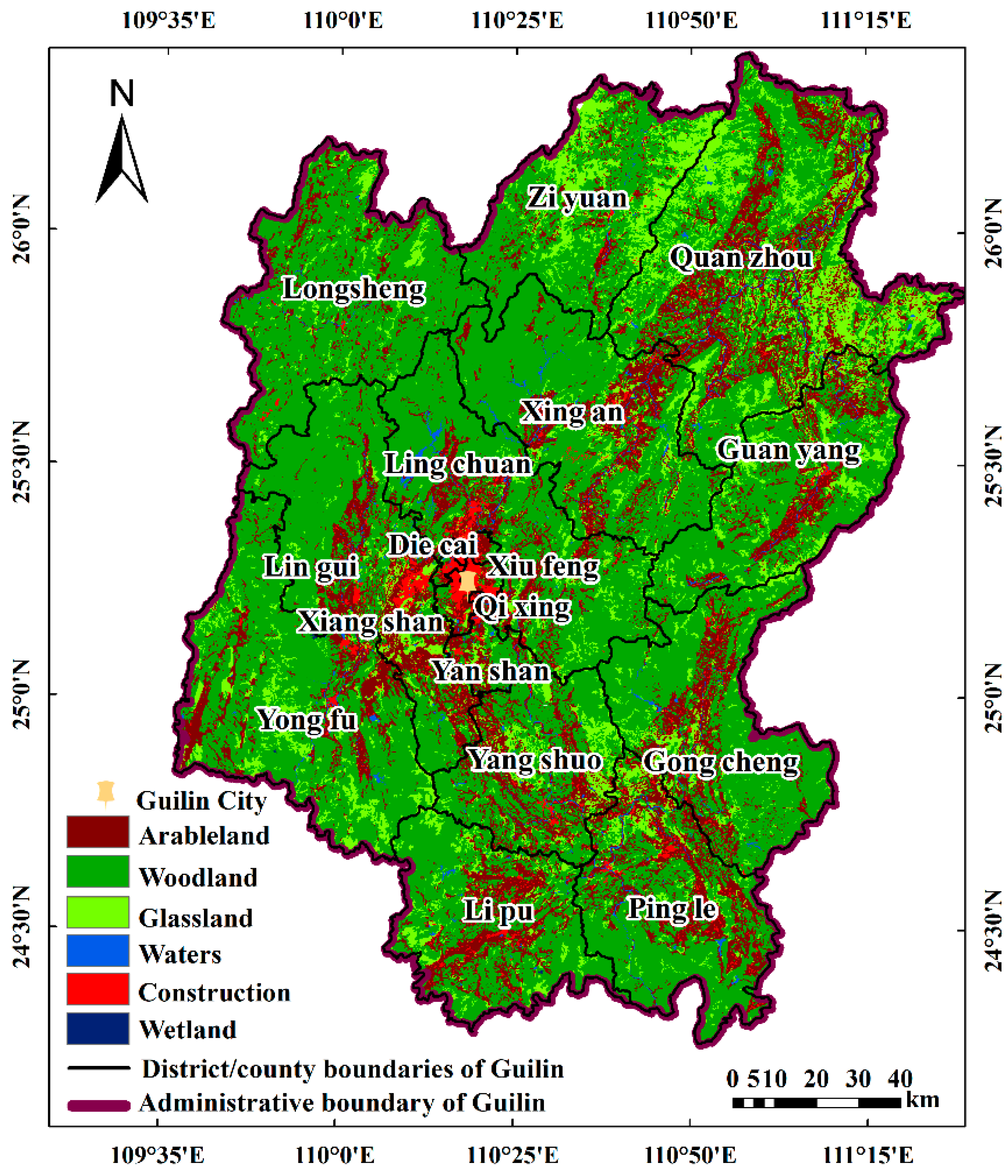
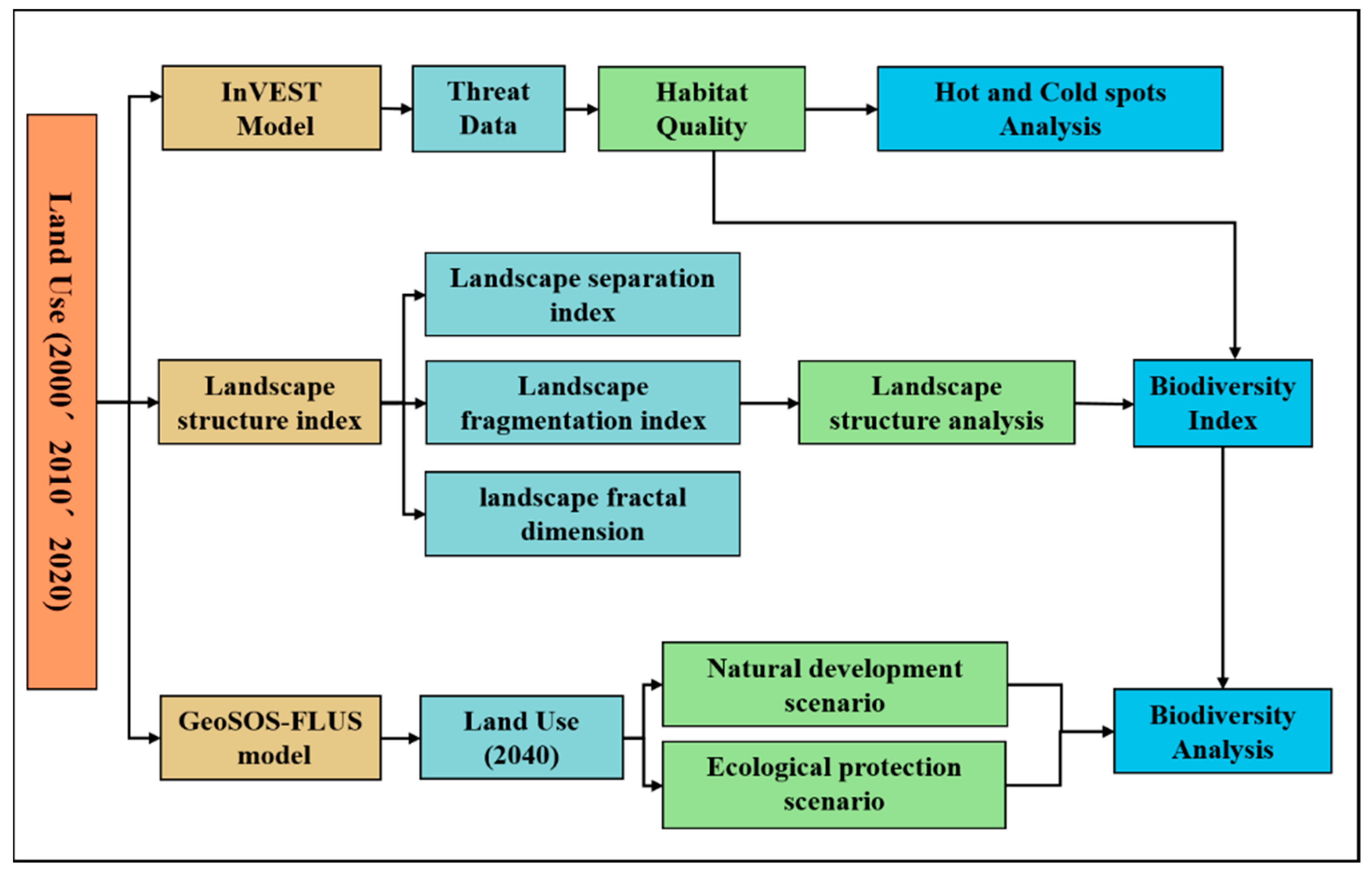
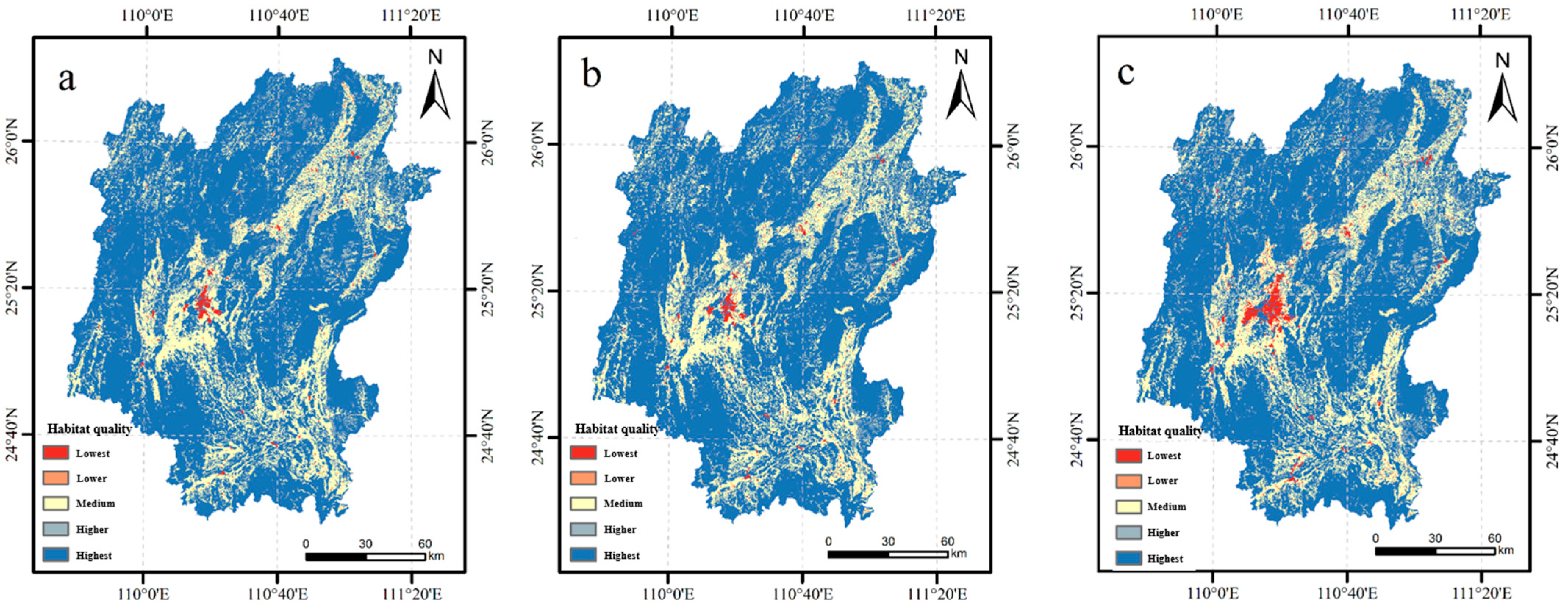

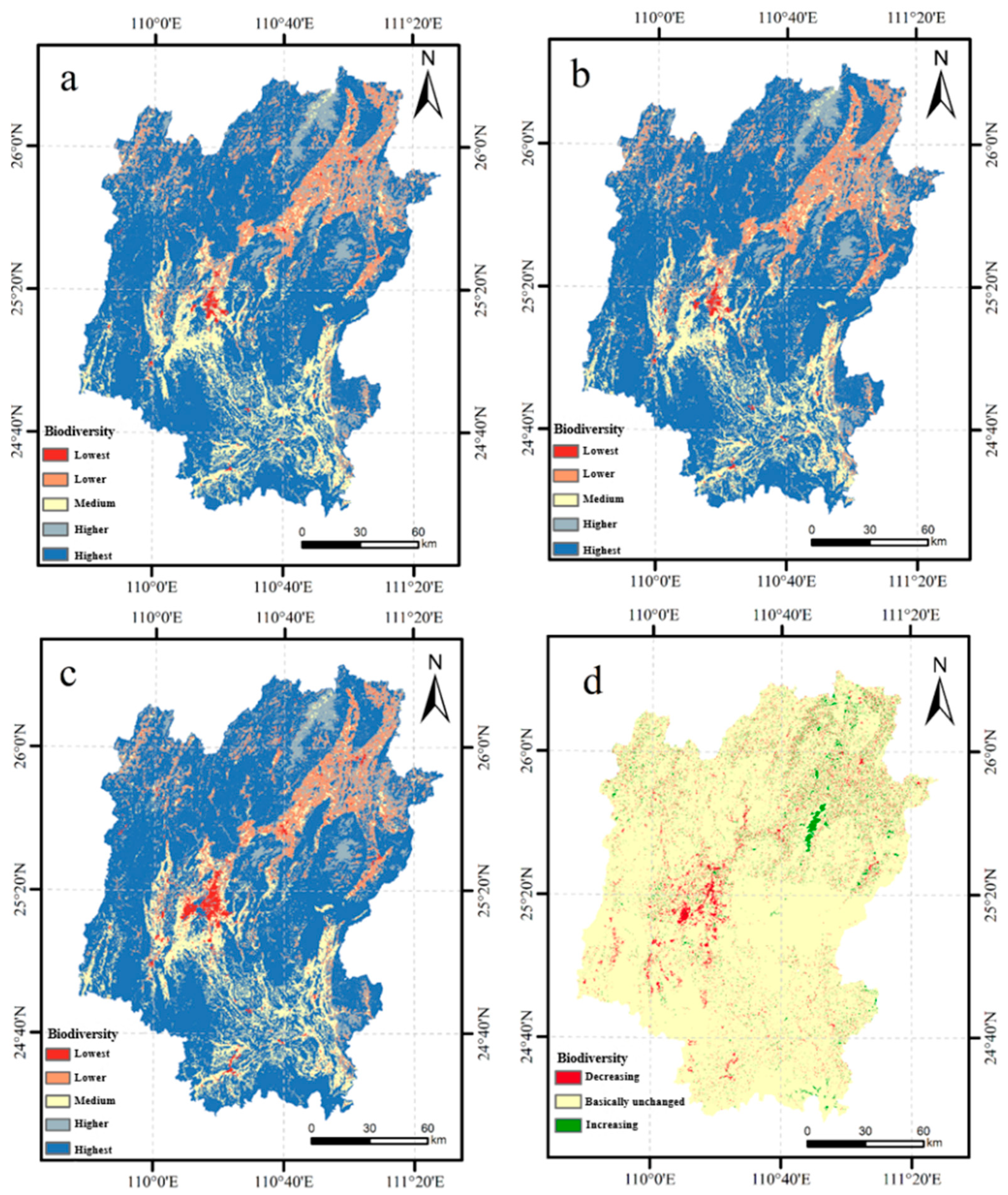
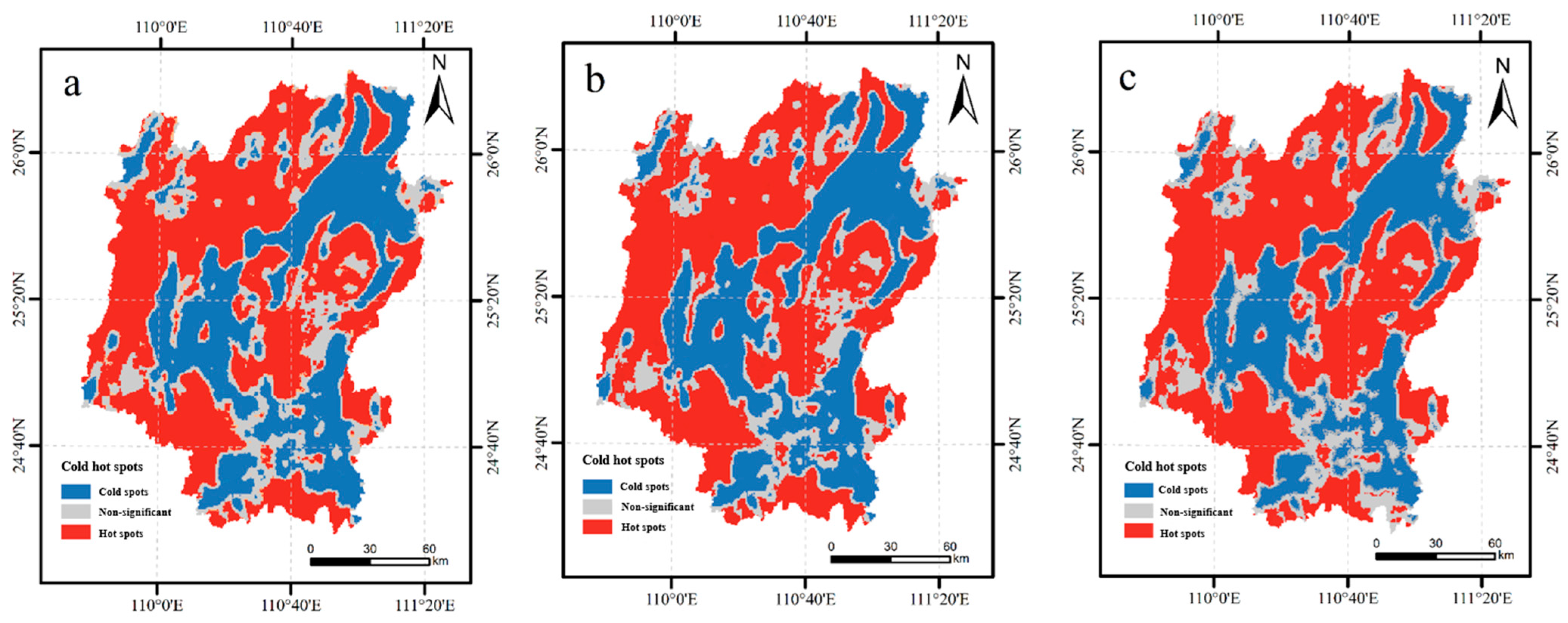

| LULC | Name * | Habitat | L_AL | L_CL |
|---|---|---|---|---|
| 1 | AL | 0.4 | 0 | 0.6 |
| 2 | WL | 1 | 0.75 | 0.9 |
| 3 | GL | 0.8 | 0.45 | 0.7 |
| 4 | WTL | 1 | 0.7 | 0.85 |
| 5 | WT | 0.9 | 0.3 | 0.75 |
| 6 | CL | 0 | 0 | 0 |
| Threat Factors | Max_Dist | Weight | Decay |
|---|---|---|---|
| Arable land | 1.5 | 0.5 | linear |
| Construction land | 5.5 | 0.9 | linear |
| Railway | 2.5 | 0.6 | linear |
| Highway | 1.5 | 0.5 | linear |
| Type * | Hot Spots (%) | Cold Spots (%) | ||
|---|---|---|---|---|
| 2000 | 2020 | 2000 | 2020 | |
| AL | 13.37 | 13.37 | 71.30 | 68.86 |
| WL | 64.19 | 64.19 | 17.24 | 16.51 |
| GL | 40.19 | 40.19 | 37.81 | 36.73 |
| WTL | 100.00 | 88.89 | 0.00 | 11.11 |
| WT | 32.68 | 32.68 | 51.58 | 51.74 |
| CL | 3.37 | 3.37 | 92.47 | 90.87 |
Disclaimer/Publisher’s Note: The statements, opinions and data contained in all publications are solely those of the individual author(s) and contributor(s) and not of MDPI and/or the editor(s). MDPI and/or the editor(s) disclaim responsibility for any injury to people or property resulting from any ideas, methods, instructions or products referred to in the content. |
© 2024 by the authors. Licensee MDPI, Basel, Switzerland. This article is an open access article distributed under the terms and conditions of the Creative Commons Attribution (CC BY) license (https://creativecommons.org/licenses/by/4.0/).
Share and Cite
Lan, Y.; Zhang, K.; Han, X.; Chen, Z.; Ling, M.; You, H.; Chen, J. The Spatiotemporal Variation in Biodiversity and Its Response to Different Future Development Scenarios: A Case Study of Guilin as an Internationally Renowned Tourist Destination in China. Appl. Sci. 2024, 14, 2101. https://doi.org/10.3390/app14052101
Lan Y, Zhang K, Han X, Chen Z, Ling M, You H, Chen J. The Spatiotemporal Variation in Biodiversity and Its Response to Different Future Development Scenarios: A Case Study of Guilin as an Internationally Renowned Tourist Destination in China. Applied Sciences. 2024; 14(5):2101. https://doi.org/10.3390/app14052101
Chicago/Turabian StyleLan, Yanping, Kaiqi Zhang, Xiaowen Han, Zizhen Chen, Ming Ling, Haotian You, and Jianjun Chen. 2024. "The Spatiotemporal Variation in Biodiversity and Its Response to Different Future Development Scenarios: A Case Study of Guilin as an Internationally Renowned Tourist Destination in China" Applied Sciences 14, no. 5: 2101. https://doi.org/10.3390/app14052101
APA StyleLan, Y., Zhang, K., Han, X., Chen, Z., Ling, M., You, H., & Chen, J. (2024). The Spatiotemporal Variation in Biodiversity and Its Response to Different Future Development Scenarios: A Case Study of Guilin as an Internationally Renowned Tourist Destination in China. Applied Sciences, 14(5), 2101. https://doi.org/10.3390/app14052101






